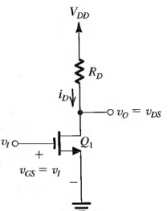Test: MOSFET In Amplifier Design - Electronics and Communication Engineering (ECE) MCQ
10 Questions MCQ Test - Test: MOSFET In Amplifier Design
(Q.1 & Q.2) Various measurements are made on an NMOS amplifier for which the drain resistor RD is 20 kΩ. First, DC measurements show the voltage across the drain resistor, VRD, to be 2 V and the gate-to-source bias voltage to be 1.2 V. Then, ac measurements with small signals show the voltage gain to be −10 V/V.
Q. What is the value of Vt for this transistor?
If the process transconductance parameter is 50μA/V2, what is the MOSFET’s W/L?
(Q.3-Q.5) Consider the amplifier below for the case VDD = 5 V, RD = 24 kΩ, (W/L) = 1 mA/V2, and Vt = 1 V.

If the amplifier is biased to operate with an overdrive voltage VOV of 0.5 V, find the incremental gain at the bias point.
If the amplifier is biased to operate with an overdrive voltage VOV of 0.5 V, find the incremental gain at the bias point.
For amplifier biased to operate with an overdrive voltage of 0.5V, and disregarding the distortion caused by the MOSFET’s square-law characteristic, what is the largest amplitude of a sine-wave voltage signal that can be applied at the input while the transistor remains in saturation?
For the input signal of 1.5V what is the value of the gain value obtained?
Which of the following is the fastest switching device?
(Q.8 –Q.10) Consider the amplifier circuit shown below. The transistor is specified to have Vt = 0.4 V, kn = 0.4 mA/V2, W/L = 10 and λ = 0. Also, let VDD = 1.8V, RD = 17.5kΩ, VGS = 0.6V and vgs = 0V.
Q. Find ID.














